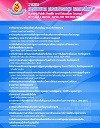ผลของการประยุกต์กระบวนการอนามัยชุมชน ร่วมกับการมีส่วนร่วมของชุมชนในการควบคุมลูกน้ำยุงลาย
คำสำคัญ:
กระบวนการอนามัยชุมชน, การมีส่วนร่วมของชุมชน, ลูกน้ำยุงลาย, Community Health Process, Community Participations, Aedes Larvaบทคัดย่อ
การมีส่วนร่วมของประชาชนในชุมชนนับเป็นปัจจัยสำคัญต่อการพัฒนาสภาวะสุขภาพ การวิจัยครั้งนี้เป็นการวิจัยกึ่งทดลอง ศึกษากลุ่มเดียววัดผลก่อนและหลังการทดลอง มีวัตถุประสงค์เพื่อศึกษาผลของการประยุกต์ใช้กระบวนการอนามัยชุมชนร่วมกับการมีส่วนร่วมของชุมชนต่อพฤติกรรมการควบคุมลูกน้ำยุงลาย กลุ่มตัวอย่างในการวิจัยครั้งนี้ คือตัวแทนครัวเรือน หมู่ที่ 2 ตำบลทับตีเหล็ก อำเภอเมือง จังหวัดสุพรรณบุรี จำนวน 80 คน โดยการสุ่มตัวอย่างแบบง่าย ซึ่งตัวแทนครัวเรือนได้รับการส่งเสริมให้เกิดพฤติกรรมการควบคุมลูกน้ำยุงลาย โดยใช้กระบวนการอนามัยชุมชนโดยใช้ชุมชนเป็นฐาน ซึ่งประกอบด้วย 1) ขั้นเตรียมชุมชน 2) ขั้นวินิจฉัยชุมชน 3) ขั้นวางแผน 4) ขั้นดำเนินกิจกรรมโดยใช้การมีส่วนร่วมของตัวแทนชุมชนและตัวแทนนักเรียนชั้นประถมศึกษาปีที่ 5 และ 6 ในการให้ความรู้และปรับเปลี่ยนพฤติกรรมการควบคุมลูกน้ำยุงลายแก่ตัวแทนครัวเรือน และ 5) ขั้นประเมินผล รวมระยะการดำเนินการวิจัย 16 สัปดาห์ เก็บรวบรวมข้อมูลโดยใช้แบบสอบถามร่วมกับการสังเกต ดำเนินการเก็บรวบรวมก่อน และหลังการทดลอง 1 สัปดาห์ วิเคราะห์ข้อมูลโดยใช้สถิติร้อยละ ค่าเฉลี่ย ส่วนเบี่ยงเบนมาตรฐาน และ Paired t-test ผลการศึกษาพบว่าหลังการทดลอง ตัวแทนครัวเรือนมีคะแนนเฉลี่ยในเรื่อง ความรู้ ทัศคติพฤติกรรมในการควบคุมลูกน้ำยุงลายสูงกว่าก่อนการทดลอง และค่าดัชนีบ้านที่พบลูกน้ำยุงลายลดลงกว่าก่อนการทดลองอย่างมีนัยสำคัญทางสถิติ (p<.05) การวิจัยครั้งนี้ จึงขอเสนอแนะว่า การประยุกต์ใช้กระบวนการอนามัยชุมชนร่วมกับการมีส่วนร่วมของชุมชน ส่งผลให้ประชาชนในชุมชนเกิดพฤติกรรมการควบคุมลูกน้ำยุงลายที่ถูกต้องเหมาะสม อีกทั้งเป็นแนวทางสำหรับบุคลากรสาธารณสุขในการกระตุ้นให้ผู้มีส่วนได้ส่วนเสียในชุมชนให้เข้ามามีส่วนร่วมในการแก้ไขปัญหาในชุมชน
Effects of Applying Community Health Process and Community Participation on the Control of Aedes Larva
Community participation is a significant factor for health development. The objective of this one group pretest-posttest quasi experimental study was to examine effects of applying the community health process and community participation on behaviors related to the control of Aedes larva. Subjects were 80 family representatives living in Muang district, Suphanburi province selected by simple random sampling. Family representatives participated in the community-based program by applying community health process. The program comprised five phases including; 1) community preparation, 2) community diagnosis, 3) planning, 4) implementations with participation of representatives from communities and students grade 5th and 6th in providing knowledge and changing behaviors related to the control of Aedes larva in each household, and 5) evaluation. The implementation of the program took 16 weeks. Data were collected using self-administered questionnaires and the observation method. Pre-test data were collected one week before starting the program and post-test data collected one week after the intervention. The results showed that the mean scores of knowledge, attitudes, behaviors related to the control of Aedes larva were significantly higher than that of the pre-test, and the House Index (H.I.) was significantly lower after intervention (p <.05). Findings suggested that the program applying the community health process and community participation could be able to encourage community members to control of Aedes larva. The program could serve as guidelines for public health staff to encourage community stakeholders to participate in solving community health problems.



